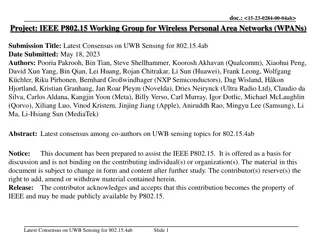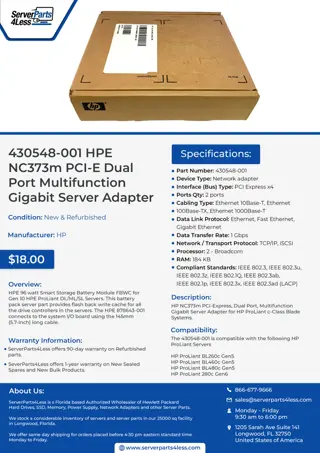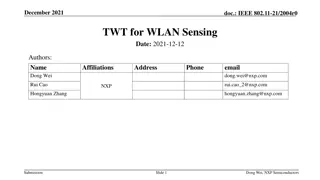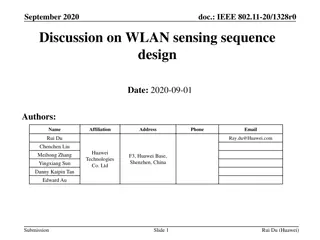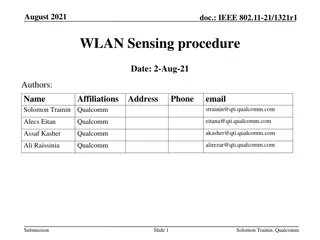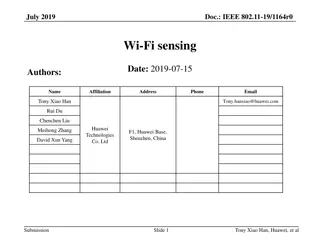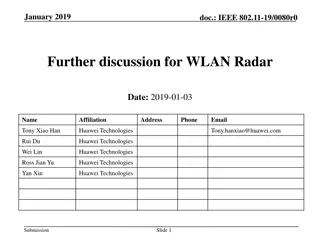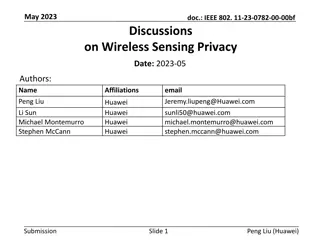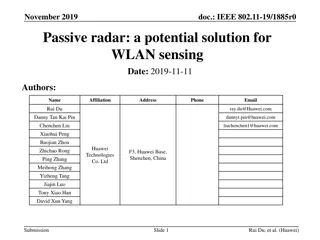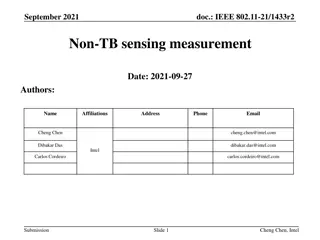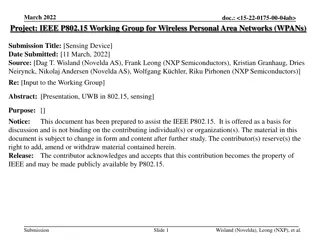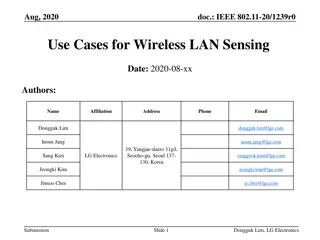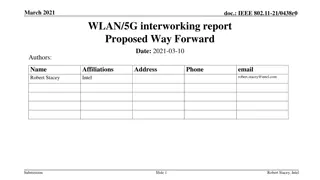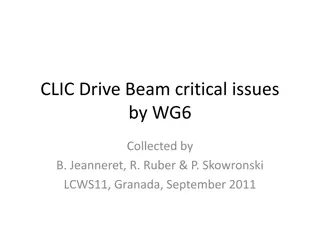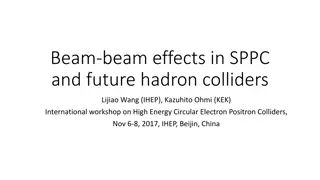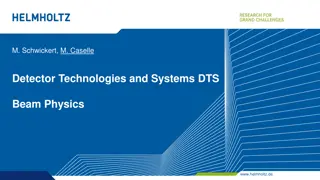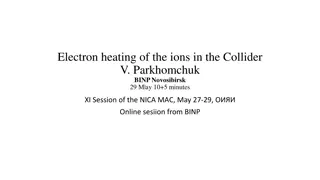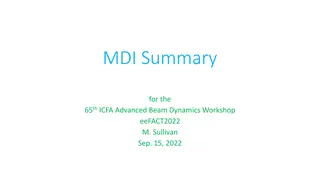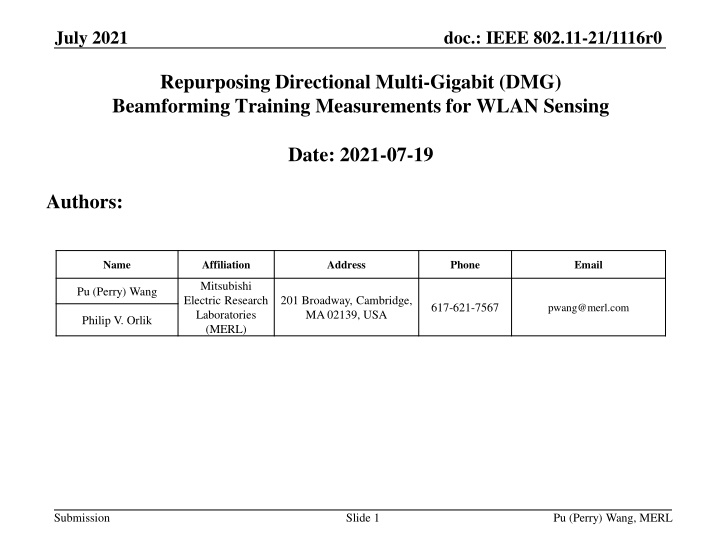
Repurposing DMG Beamforming for WLAN Sensing at 60 GHz
Explore the repurposing of Directional Multi-Gigabit (DMG) beamforming training measurements for WLAN sensing at 60 GHz, revisiting DMG protocols and utilizing channel measurements for localization, occupancy sensing, and pose recognition in wireless networks.
Download Presentation

Please find below an Image/Link to download the presentation.
The content on the website is provided AS IS for your information and personal use only. It may not be sold, licensed, or shared on other websites without obtaining consent from the author. If you encounter any issues during the download, it is possible that the publisher has removed the file from their server.
You are allowed to download the files provided on this website for personal or commercial use, subject to the condition that they are used lawfully. All files are the property of their respective owners.
The content on the website is provided AS IS for your information and personal use only. It may not be sold, licensed, or shared on other websites without obtaining consent from the author.
E N D
Presentation Transcript
doc.: IEEE 802.11-21/1116r0 July 2021 Repurposing Directional Multi-Gigabit (DMG) Beamforming Training Measurements for WLAN Sensing Date: 2021-07-19 Authors: Name Affiliation Address Phone Email Mitsubishi Electric Research Laboratories (MERL) Pu (Perry) Wang 201 Broadway, Cambridge, MA 02139, USA 617-621-7567 pwang@merl.com Philip V. Orlik Submission Slide 1 Pu (Perry) Wang, MERL
doc.: IEEE 802.11-21/1116r0 July 2021 Abstract This contribution is a continuation of 20/1074r1 WLAN Localization and Sensing With Mid-Grained Channel Measurements 20/1741r1 Feasibility study of human pose and occupancy classification using mmWave WiFi beam attributes 21/0407r3 Multi-Band WiFi Fusion for WLAN Sensing Occupancy Sensing Open dataset for mid-grained WiFi channel measurements Pose recognition https://www.merl.com/demos/mmBSF which adopts directional multi-gigabit (DMG) beamforming training measurements, e.g., beam SNRs, at 60-GHz for WLAN sensing. This contribution revisits DMG beamforming training (BFT) protocols at the 802.11ad & ay standards and repurposes the DMG BFT measurements for WLAN Sensing. Submission Slide 2 Pu (Perry) Wang, MERL
doc.: IEEE 802.11-21/1116r0 July 2021 Channel Measurements at Sub-7 GHz Multiple WiFi channel measurements are considered for WLAN Sensing RSSI: single value signal strength indicator CSI or compressed version: Complex amplitudes at freq.-domain OFDM subcarriers (802.11g/n/ac at sub-7 GHz) Power delay profile or truncated version: can be obtained via inverse FFT (coarse resolution) or time-reversal methods (fine resolution) coarse-grained RSSI Delay profile fine-grained CSI Echo signals at sub-7 GHz Multipath propagation at sub-7 GHz Channel Measurements at sub-7 GHz Submission Slide 3 Pu (Perry) Wang, MERL
doc.: IEEE 802.11-21/1116r0 July 2021 Channel Measurements at 45+ GHz All previous measurements can be defined also at 60 GHz RSSI: single value signal strength indicator CSI: Complex amplitudes at freq.-domain OFDM subcarriers (802.11g/n/ac at sub-7 GHz) Power delay profile: can be obtained via inverse FFT (fine resolution due to wider bandwidth) or time- reversal methods (fine resolution) DMG Beamforming Training (BFT) Measurements: Spatial-domain channel measurements at mmWave bands, weighted by beam patterns (sectors) DMG beamforming training measurements Channel measurements at 45+ GHz (during beam training) Echo signals at 45+ GHz Multipath propagation at 45+ GHz Submission Slide 4 Pu (Perry) Wang, MERL
doc.: IEEE 802.11-21/1116r0 July 2021 Comparisons CSI at sub-7 GHz DMG BFT Measurements at 60 GHz frequency-domain CFR; delay-domain CIR spatial-domain link quality over beamforming patterns sensitive to only large motions/distinct patterns (*if the coarse beampatterns at commercial devices) sensitive to both subtle & large motions cover large areas (pass through walls) cover small areas (blocked by obstacles) richer multipath sparse propagation paths (with cluster/group structures) Limited number of antennas with omnidirectional beampatterns Phased array with directional beampatterns inconsistent measurements (channel fading, sensitive to environmental dynamics pet, movable home appliances) more repeatable (even in the presence of disturbance) high dimension (no. subcarriers x no. antennas) medium/low dimension (no. of beampatterns) Submission Slide 5 Pu (Perry) Wang, MERL
doc.: IEEE 802.11-21/1116r0 July 2021 Revisiting 802.11bf PAR Scope of WLAN Sensing Defines modifications to the IEEE 802.11 medium access control layer (MAC) and to the Directional Multi Gigabit (DMG) and enhanced DMG (EDMG) PHYs to enhance Wireless Local Area Network (WLAN) sensing (SENS) operation in license-exempt frequency bands between 1 GHz and 7.125 GHz and above 45 GHz. Enables stations to perform one or more of the following: to inform other stations of their WLAN sensing capabilities, to request and setup transmissions that allow for WLAN sensing measurements to be performed, to indicate that a transmission can be used for WLAN sensing, to exchange WLAN sensing feedback and information Defines WLAN sensing measurements to be obtained using transmissions that are requested, unsolicited, or both Enables a MAC service interface for layers above the MAC to request and retrieve WLAN sensing measurements. Submission Slide 6 Pu (Perry) Wang, MERL
doc.: IEEE 802.11-21/1116r0 July 2021 DMG Beacon at 60 GHz (802.11ad/ay) Beacon interval (BI) was amended at 802.11ad & ay for network announcements , coordination, and parameter exchange with directional antenna sectors. Beacon header interval (BHI) for bi-directional beamforming training and schedule/ medium access parameter management; Data Transmission Interval (DTI) for data communications with contention-based/contention- free periods. BHI has up to three sub-intervals Beacon transmission interval (BTI) consists of multiple beacon frames for network announcements over different beam sectors and train beam sectors of AP/Initiator Association beamforming training (A-BFT) is used to train beam sectors of stations (SLS) Beam Refinement phase (BRP) can be added during the DTI. Submission Slide 7 Pu (Perry) Wang, MERL Figure from [21]
doc.: IEEE 802.11-21/1116r0 July 2021 802.11ad/ay Beamforming Training Protocols Beamforming training determines the appropriate receive and transmit antenna sectors for a pair of stations for establishing data transmission link Mandatory sector-level sweep (SLS): identify coarse-grained antenna sector configuration and Optional beam refinement phase (BRP): fine-tunes the selected sectors During SLS, either initiator or responders uses multiple sector sweep (SSW) frames to train either TXSS or RXSS Transmit sector sweep (TXSS): Tx sends directional beam sectors and Rx with quasi-omnidirectional beam patterns; For instance, the Rx calculate the beam sector SNR for each transmitted beam sectors. Receive sector sweep (RXSS): Tx sends omni-directional beam patterns and Rx with directional beam sectors. Initiator TXSS, Responder RXSS, Initiator RXSS, and Responder TXSS Feedback to the initiator (e.g., Initiator TXSS) is done by every Responder SSW frame with feedback Feedback to the responder (e.g., responder TXSS) is done with a single SSW feedback frame. Submission Slide 8 Pu (Perry) Wang, MERL Figure from [21]
doc.: IEEE 802.11-21/1116r0 July 2021 802.11ad/ay Beamforming Training Protocols During Association beamforming training (A-BFT), the A-BFT interval is divided into multiple responder slots (A-BFT slot) Each A-BFT slot consists of a number of responder SSW frames. To allow multiple responders, a contention-based scheme* is used Contending stations randomly select which slot to access. A collision is detected by a missing SSW Feedback frame from the AP. *can be modified to enhance initiator-responder measurement/result exchange for WLAN sensing Figure from [21] Submission Slide 9 Pu (Perry) Wang, MERL
doc.: IEEE 802.11-21/1116r0 July 2021 Example: Initiator collects all types of BFT measurements Time AP STA (Initiator SLS) (Responder SLS) Initiator TXSS (AP: directional Tx sectors; Client: quasi-omni Rx) Initiator RXSS (AP: directional Rx sectors; Client: quasi-omni Tx) Initiator RXSS (AP: quasi-omni Tx; Client: directional Rx sector) Responder TXSS (AP: quasi-omni Rx; Client: directional Tx sectors) Initiator computes BFT data (Responder Tx beam SNRs) Responder computes BFT data (Initiator Tx beam SNRs) Responder computes BFT data (Responder Rx beam SNRs) Initiator computes BFT data ( Initiator Rx beam SNRs) Feedback previous responder BFT data to Initiator Submission Slide 10 Pu (Perry) Wang, MERL
doc.: IEEE 802.11-21/1116r0 July 2021 Feasibility Study using DMG BFT Measurements from Commercial-Off-The-Shelf mmWave Routers Client at one location o 32-element array in one finger Time AP 1 AP 2 Client Client (Initiator SLS) (Initiator SLS) (Responder SLS) (Responder SLS) Initiator TXSS (AP: directional Tx sectors; Client: quasi-omni Rx) Initiator TXSS (AP: directional Tx sectors; Client: quasi-omni Rx) Client computes BFT data (Initiator Tx beam SNRs) Clients computes BFT data (Initiator Tx beam SNRs) Responder (client) sends BFT data via ethernet cable to workstation Submission Slide 11 Pu (Perry) Wang, MERL
doc.: IEEE 802.11-21/1116r0 July 2021 Localization Performance (over 7 locations) AP 3 AP 1 AP 2 AP 2 + AP 3 AP 1 + AP 3 AP 1 + AP 2 Submission Slide 12 Pu (Perry) Wang, MERL
doc.: IEEE 802.11-21/1116r0 July 2021 Occupancy Sensing Performance (over 8 patterns) Picture source: TP-Link DMG-BFT Measurements Submission Slide 13 Pu (Perry) Wang, MERL
doc.: IEEE 802.11-21/1116r0 July 2021 Conclusions This contribution revisits DMG beamforming training protocols at 802.11ad/ay standards and repurposes the DMG BFT measurements for WLAN Sensing. Our earlier feasibility studies (localization, pose recognition, and indoor occupancy sensing) show the potential value of repurposing the DMG BFT measurements for WLAN sensing. Additional PHY modifications can be introduced to further facilitate the exchange of DMG BFT measurements among sensing initiator, responders, transmitters, receivers, and processors. Submission Slide 14 Pu (Perry) Wang, MERL
doc.: IEEE 802.11-21/1116r0 July 2021 References [1] CSI-based Wi-Fi Sensing: Results and Standardization Challenges, IEEE 802.11-19/1769r1 [2] 802.11 sensing: Applications, feasibility, standardization, IEEE 802.11-19/1626r1 [3] Wi-Fi sensing in 60GHz band, IEEE 802.11-19/1551r1 [4] Wi-Fi sensing, IEEE 802.11-19/1164 [5] Wi-Fi sensing: cooperation and standard support, IEEE 802.11-19/1416 [9] D. Steinmetzer, D. Wegemer, M. Schulz, J. Widmer, and M. Hollick, Compressive millimeter-wave sector selection in off-the-shelf IEEE 802.11ad devices, in Proc. 13th Int. Conf. Emerg. Netw. EXperiments Technol., Nov. 2017 [10] D. Steinmetzer D. Wegemer and M. Hollick Talon Tools: The Framework for Practical IEEE 802.11ad Research 2018 [online] Available: https://seemoo.de/talon-tools/ [11] M. Schulz D. Wegemer and M. Hollick Nexmon: The C-Based Firmware Patching Framework 2017 [15] T. Koike-Akino, P. Wang, M. Pajovic, H. Sun and P. V. Orlik "Fingerprinting-based indoor localization with commercial mmWave WiFi: A Deep Learning Approach , IEEE Access, Vol. 8, pp. 84879-84892, 2020. [16] J. Yu, P. Wang , T. Koike-Akino, Y. Wang, and P. V. Orlik " Human Pose and Seat Occupancy Classification with Commercial mmWave WiFi , GLOBECOM Workshop on JSAC, December, 2020. [17] WLAN Localization and Sensing With Mid-Grained Channel Measurements, IEEE 802.11-20/1074r1 [18] Feasibility study of human pose and occupancy classification using mmWave WiFi beam attributes, IEEE 802.11- 20/1741r1 [19] Multi-Band WiFi Fusion for WLAN Sensing, IEEE 802.11-21/0407r3 [20] IEEE 802.11 WG, IEEE 802.11ad, Amendment 3: Enhancements for Very High Throughput in the 60 GHz Band, Dec. 2012. [21]T. Nitsche et al., "IEEE 802.11ad: directional 60 GHz communication for multi-Gigabit-per-second Wi-Fi [Invited Paper]," in IEEE Communications Magazine, vol. 52, no. 12, pp. 132-141, December 2014. [22] P. Zhou et al., "IEEE 802.11ay-Based mmWave WLANs: Design Challenges and Solutions," IEEE Communications Surveys & Tutorials, vol. 20, no. 3, pp. 1654-1681, 2018. [23] IEEE 802.11ay, Amendment 7: Enhanced throughput for operation in license-exempt bands above 45 GHz, IEEE Std 802.11ay/Draft 0.5-2017, pp. 1-364, Aug. 2017. Submission Slide 15 Pu (Perry) Wang, MERL
doc.: IEEE 802.11-21/1116r0 July 2021 Straw Poll Should802.11bf TG consider directional multi-gigabit (DMG) beamforming training (BFT) measurements at 45+ GHz as one type of sensing measurements for WLAN Sensing? Yes: No: Abstain: Related Document (SP): 21/0407r3 (Y/N/A: 18/4/16) Beamforming training includes Initiator TXSS, Initiator RXSS, Responder TXSS, Responder RXSS during BHI (beacon header interval) and DTI (data transmission interval). Submission Slide 16 Pu (Perry) Wang, MERL

